Conservation is going to the dogs
Detection canines are playing a vital role in saving rare plants and animals
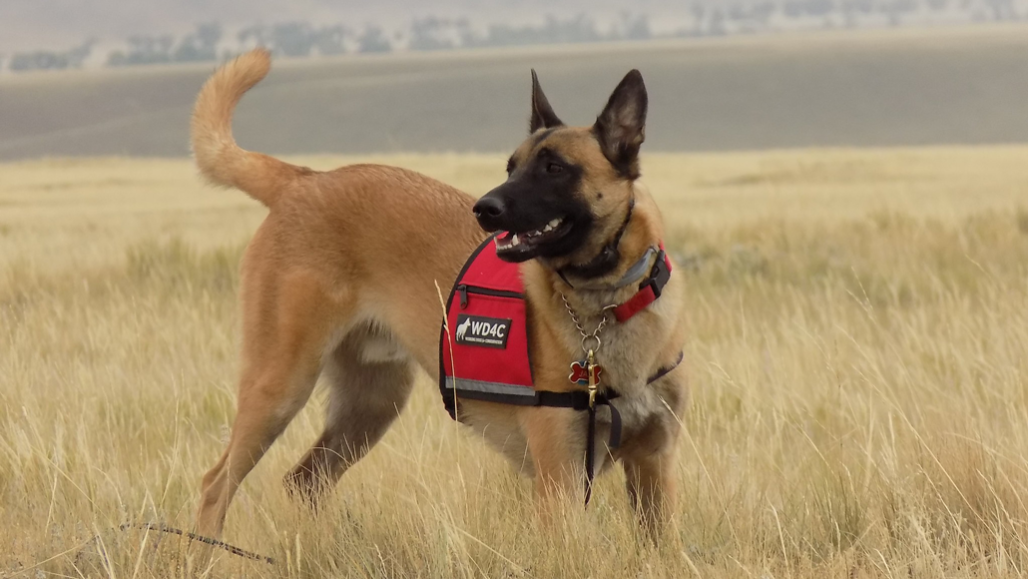
Jax, here, is a canine with Working Dogs for Conservation (WD4C). He helps search for black-footed ferrets.
Working Dogs for Conservation
Kayla Fratt greets a driver as he hauls his boat toward one of three boat ramps in Wyoming’s Yellowstone National Park.
“Can my dog check your boat?” she asks. “He’s looking for zebra mussels.”
The driver, curious, agrees. He and his family climb out of the car, asking Fratt questions as Barley, a border collie, goes to work. Barley sniffs his way around the boat, while Fratt tells the family about zebra mussels.
Native to Russia and Ukraine, the mussels have cropped up in lakes around the world. They’re small. Adults are usually the size of a fingernail. But they reproduce in massive numbers, clinging to and gumming up drainage pipes, power plants, waterways and more. Zebra mussels eat the algae that native mussels and other aquatic animals need to survive. Without food, the native species die off. Meanwhile, the zebra mussels continue to spread. They’re what scientists call an invasive species.
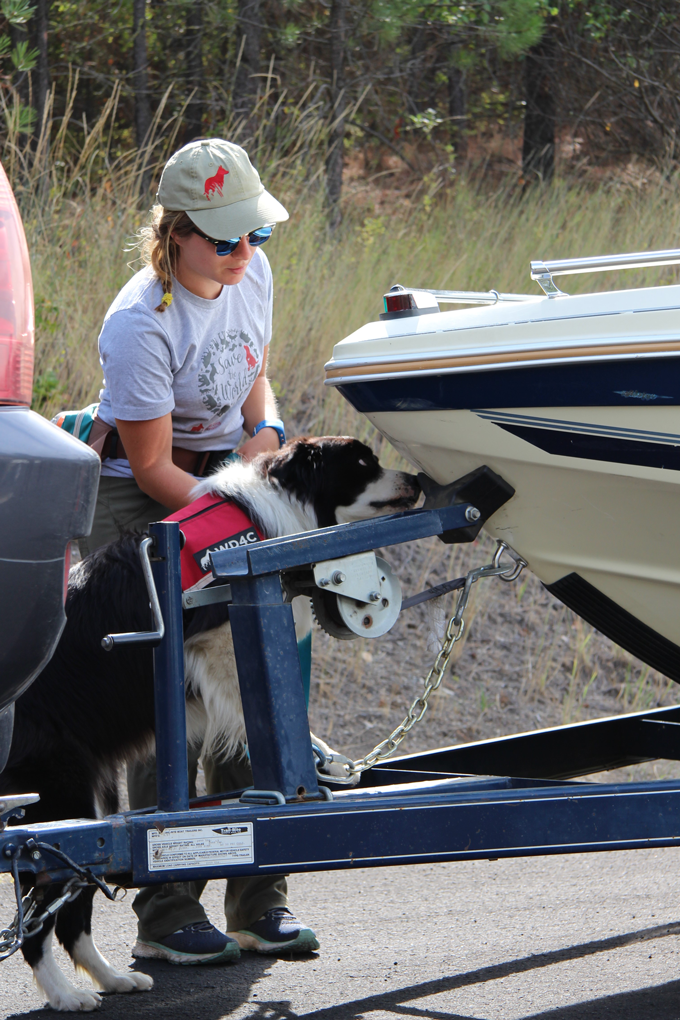
The only way to fight these mussels is to stop their tiny larvae from hitching a ride to new places. But those larvae, about as big as the width of two human hairs laid side-by-side, are tough to spot. They get into the tiny crevices of boats and motors, hiding until they reach a new lake. There they float free, starting a new infestation.
Barley’s tail starts a slow, sweeping wag. He closes his mouth and sniffs more intently. He senses something. When he locates it, he lies down with his nose pointing to the spot. Fratt inspects the area closely and pulls out a hidden vial. The vial contains zebra mussels. She had planted it on the boat while Barley was working.
It’s a super big deal — and fortunately rare — to find zebra mussels during a boat inspection, Fratt says. The vial will help keep Barley’s nose homed into the target scent. Fratt pulls a squeaky ball from a bag and throws it to the dog for a vigorous round of play.
Fratt and Barley are key members of Working Dogs for Conservation, or WD4C. The Montana-based organization trains dogs to help with conservation projects. These programs include searching for invasive species like the zebra mussels and tracking rare and endangered animals. Some WD4C dogs live in Africa, where they help park rangers fight wildlife poaching, the illegal killing of wild animals.
These dogs aren’t ordinary pets. Some started out as service or military dogs and didn’t do well in those lines of work. Most detection dogs did start off as pets, Fratt says. But they’re “ball-crazy” and full of energy. And that can be too much for some owners to handle.
“The dogs tend to end up in the shelter a lot,” she says. The reason: “Because they’re so high energy and go-go-go.” That boundless energy often isn’t a good fit for pet owners, Fratt says. But it’s ideal for a detection dog. A ball is the perfect reward. It’s easy for the person who works with the dog, its handler, to carry. A ball can’t spoil the way food treats might. And ball-crazy dogs will do almost anything to get that reward. That makes them easy to train.
These dogs learn that when they smell a certain scent, they get to play with their ball. Each dog is trained to detect specific odors. It might be those zebra mussels. Or it could be the poop from a certain species of animal — or the animal itself. It might even be plants or plant parts. All are organisms that can be easy for people to miss without some help.
Fighting a plant invasion
On a recent day in Iowa, two WD4C dogs, Utah and Lily, are working with biologist Aimee Hurt. Hurt helped create WD4C and directs their special projects. Noses raised to catch the wind, the dogs dash across the tall-grass prairie. They are snaking back and forth in search of the scent that will get them their ball. It’s hard work on a hot day. They take turns hunting for their target, Chinese bushclover.
This invasive species releases chemicals that prevent other plants from growing. And it is taking over native landscapes across the eastern United States. It looks a lot like round-headed bushclover, a close relative that’s native to the United States. Even for people who are trained to tell the difference, it’s easy to miss these shorter plants in the sea of tall grasses.
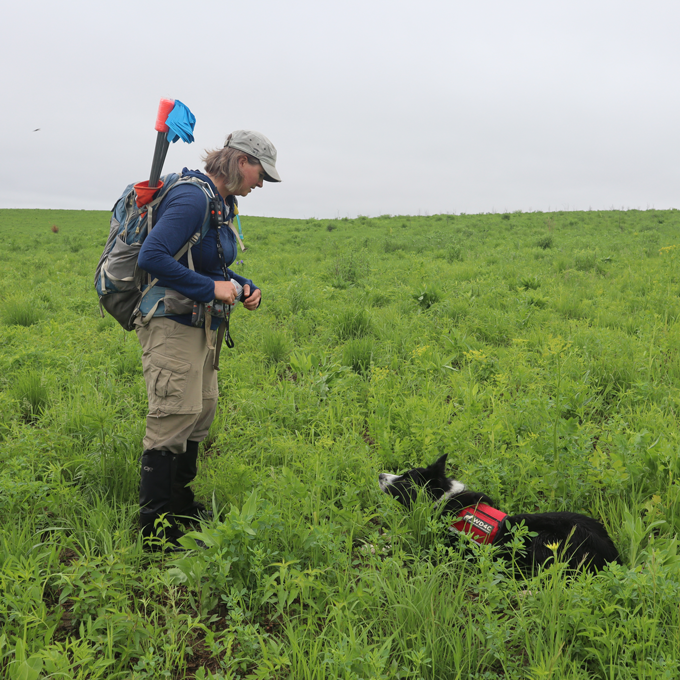
Each time a dog finds a patch of Chinese bushclover, it lets Hurt know. She marks the patch with a flag and takes careful notes. Someone else will return later to remove the invaders.
Utah and Lily are an essential tool in the fight against invasive plants. Their super-sensitive sniffers pick up odors that people can’t detect. What’s more, they are able to tell scents apart, even ones that are quite similar. Those two types of bushclover, for instance. Other dogs, trained to find scat, can tell droppings from diseased deer from those of healthy deer. Or one type of bear from another. Some dogs can even identify scat from one individual animal.
Scent detection dogs aren’t new to the world of conservation. Samuel Wasser first put dogs to use in his research in 1997. Wasser is a conservation biologist at the University of Washington in Seattle. He has studied animals the world over using only scat: baboons, bears, elephants, sea lions, owls, caribou and more. Wasser discovered that he could get DNA, hormones, toxins and other information out of scat. By studying those bits of dung, he can find and follow an entire population of animals without ever seeing one individual.
Wasser directs the university’s Center for Conservation Biology. At one point, the center had 21 detection dogs working on projects. “It became hard to manage all those dogs and projects,” Wasser says. So the program shrank to five dogs. This helped to better focus on key projects at his center. Many of the original dogs got old and retired from detection work to live with their handlers.
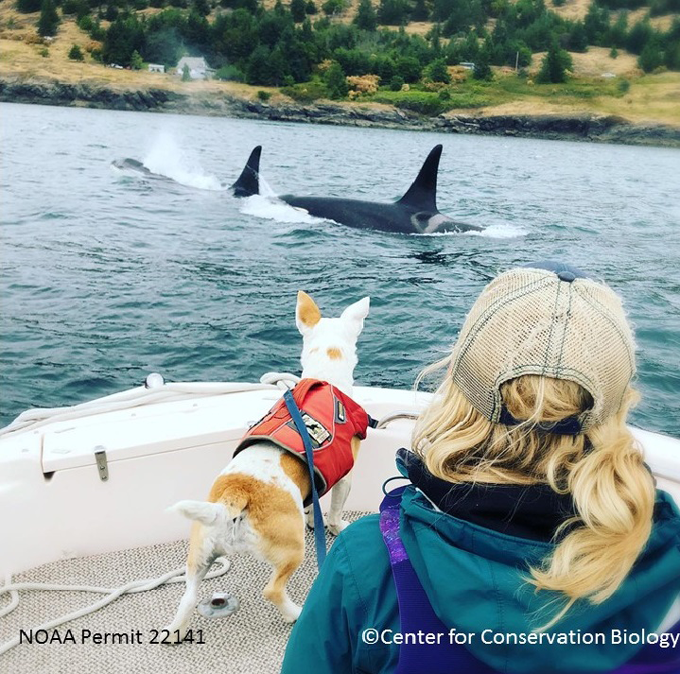
Some dogs now working at the center are trained to detect scat from orcas (killer whales). Sitting at the bow of a boat, they sniff the air blown toward them from a pod of orcas. When a whale poops, the dog leans in that direction, telling the boat driver where to go. Researchers can then scoop the goopy poop into a plastic container and take it back to the lab for study.
This work has led researchers to conclude that orcas that live off the coast of Washington “are on their way out,” Wasser says. One big reason is hunger. Human activity has reduced the number of Chinook salmon, which is the favorite food of these orcas. Pollution is another problem. Pollutants get into the whales’ bodies, where they’re stored in fat. When the orcas go hungry, they burn that fat, releasing toxic chemicals into the blood where they can now harm the whales.
Other dogs working with the center are tracking wolves and their prey. Wolves are becoming more common in central Washington. Researchers want to know how their presence might be affecting other predators in the area. The dogs on this project are trained to find scat from carnivores: wolves, coyotes, cougars, bobcats and black bears.
In four six-week sessions, the dogs found 8,000 piles of poop — most of which would have been missed by people relying strictly on sight.
“We know where we found the [scat],” Wasser says. And from the poop, “we get DNA, telling us who pooped and what they were eating.” This lets the team see how the various carnivores are moving around. And that’s leading to insights about how competition with wolves is changing the diet of those other carnivores. Says Wasser, “Dog sampling is fantastic for that.”
Not for everyone
Detection dogs can be incredibly useful to conservation biologists. But not every dog — and not every handler — is cut out for the job. Fratt and Wasser agree that high-energy, ball-crazy rescue dogs make great detection dogs. It can be a win all around — especially when homeless dogs find a home and a purpose helping wildlife.
However, not all of those dogs work for every project, cautions Karen DeMatteo. She’s a conservation biologist at Washington University in St. Louis, Mo. Choosing well can mean the difference between a successful project and one that fails.
In Argentina, DeMatteo’s Chesapeake Bay retriever, Train, helped her find scat from jaguars, ocelots, pumas, bush dogs and small spotted cats called oncillas. Tracing their movements by tracking scat, her research team is now working to create protected areas between farms and communities. Train was perfect for this job because his thick coat protected him from plants with spines and prickles. His medium size let him clamber over some obstacles — such as fallen logs — and burrow under others. And his solid paws gave him good traction on the uneven ground.
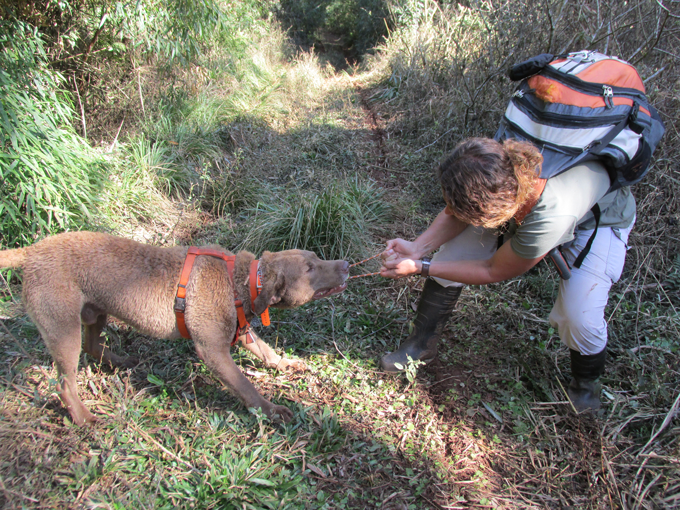
A dog’s height, coat and paws are important things to consider when choosing a dog for a project, DeMatteo says. Searches in tall vegetation need tall dogs. Short dogs have to work too hard just to break through the brush, she says. They’ll wear out too quickly. If the area is thorny, then dogs with longer fur will be better protected. But if there are lots of ticks or burrs, that long fur will become a problem and shorter-haired dogs should be used instead. Even the shape of the foot matters, she notes. Narrow feet will sink in mud or sand. Wide feet that splay out to support the dog’s weight are better in those situations.
Proper training is critical to a successful project, DeMatteo notes. If the samples used to train dogs are too limited, the dogs will be more likely to make mistakes in the field. All scat from a certain species of animal, for instance, won’t smell exactly the same. (Think about how yours might smell differently after different meals.) If too few samples are used in training, dogs might end up looking only for females, for example, instead of including males too, or only flowers in bloom instead of that plant after it has gone to seed.
Exposing the dogs to a variety of samples actually helps them narrow down what they are looking for. They’re able to ignore odors that might have come from how the samples were collected or stored. And if there are other species that eat the same foods, it’s important to include those when training the dog, DeMatteo says. Otherwise, “the dog may locate samples that you are not looking for,” she says. For example, it may find both coyote and wolf scat when you only want wolves.
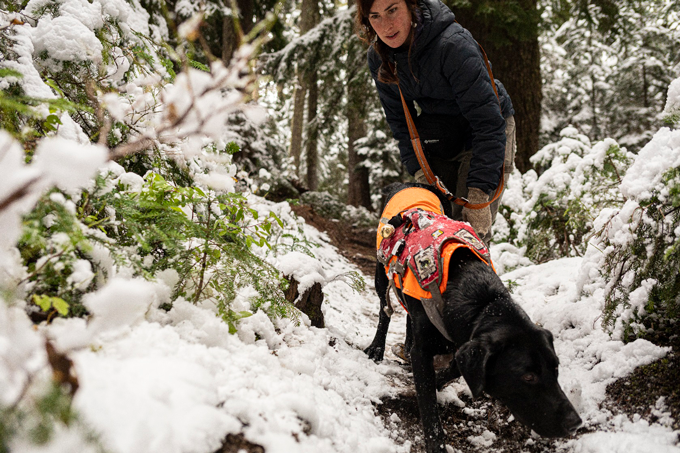
Just as important as the dog and training is the handler. “Handlers need to be able to have both physical and mental endurance,” DeMatteo says. They have to spend time away from friends and family when they’re out in the field. Personality matters too. Handlers must be able to watch their dog closely during training and while working. People who are easily distracted when they’re supposed to be working will miss important cues from their dogs, she says. Many dog-loving people aren’t cut out for the job.
And even if the dog and handler might be perfect for a job, they both need special training before they can work in the field. “Knowing how to train for basic obedience is not the same as training a dog for work in varying field conditions,” DeMatteo says.
Wasser agrees. Knowing how to sit or shake hands isn’t part of this job. “You don’t want that dog to heel,” he says. For most detection dogs to work effectively, they must be off leash. “You want that dog to be out there really working and to trust you. And you’ve got to trust the dog.” A good handler has that trust. “Our dogs never run away,” Wasser says. “Because we’re holding their most treasured reward — their ball — and they know it.”
Working with detection dogs “can be rewarding and exciting,” DeMatteo says. “It can bring you to beautiful environments, allow you to explore amazing cultures and meet incredible people.” And, she adds, “it can allow you to collect data on species in environments that are impossible using other survey techniques.”
It also “requires hard work and attention to detail to be successful,” DeMatteo says. Is it worth it? She thinks so. Success provides the data needed to protect threatened and endangered animals. For dog-lovers, it’s more than taking your furry friend to work — it creates a close, lasting partnership that really makes a difference.
When dogs go wild
Dogs aren’t always a good thing for conservation, especially when they run free. Some dogs escape captivity and become feral, or wild. Others belong to people who let them run loose. In either case, dogs can — and do — endanger local wildlife.
That threat may be direct. Julie Young is a wildlife biologist with the U.S. Department of Agriculture in Logan, Utah. She and her coworkers have seen free-roaming dogs hunt and kill mountain sheep in Central Asia. They have watched dogs chase gazelles in Tibet. In Mongolia, dogs chased after endangered saiga antelope.
Dogs can pose less obvious problems, too. They spread diseases, such as canine distemper virus and rabies, that can kill wildlife and even people. They compete with local predators for food. And they have been found hunting livestock. When this happens in areas with wolves or other wild predators, those predators are usually blamed and sometimes killed.







